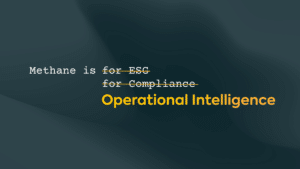On April 17, 2023, Earthworks, in partnership with Oil Change International published a report titled, “Certified Disaster.” Unfortunately, the report contains a number of inaccurate and misleading claims related to our company, our technology, and our environmental risk assessment program. We take any allegation related to the quality of our work seriously because we are a mission-driven B-Corp dedicated to deploying the best science, analytics, and technology to help companies precisely measure, quantify, and mitigate emissions as well as to improve operations related to environmental risks.
The report makes its claims centered on two main “findings”: allegations about the functionality of our devices at certain locations in Colorado and assertions about the integrity of our environmental risk assessments.
In a section of the report titled “Groundtruthing Project Canary’s Methane Emission Monitoring,” the Earthworks report explains that they used OGI cameras to assess the performance of Canary S continuous emissions monitoring (CEM) devices at a number of well sites in Colorado. The Canary S Units are devices that take 6,000 readings per week, detect target emissions down to less than 1 ppm, and report their measured values instantly to a cloud-based dashboard. Data derived from these devices serve specific client regulatory reporting requirements. OGI cameras, though they have their applications, do not quantify releases, and do not distinguish among the constituents of observed plumes.
The Earthworks report criticizes the quality of Project Canary’s methane monitoring by describing 14 instances in which it says Canary S devices failed to detect excess emissions. This would perhaps be a significant criticism if the Canary S units were actually designed to detect methane, but they are not. The Canary S devices instead detect and report Volatile Organic Compounds (VOCs). That is their purpose under Colorado’s Regulation 7 regime. Our customers use other Canary models when their need is to detect, assess, and quantify methane emissions. Those models were not deployed at these locations.
The Earthworks report’s apparent method was to point an OGI camera at a facility, then, if the camera showed what looked to Earthworks like a large plume of some gas or vapor, Earthworks would request the operator’s monitoring data for the facility. If the reported numerical values of VOCs for the facility did not exceed alert levels, which are set by the operators and approved by the state Air Pollution Control Division, Earthworks declared this a failure to detect the emissions. In other words, Earthworks saw an unknown amount of an unknown gas, and then declared the Canary S monitors to have failed if they did not report a specific value for a specific gas.
The flaws in this approach are obvious and become even more stark when assessed in light of the facts at the locations in question. Project Canary’s technical team compared the Earthworks report’s assertions to the data at the sites in question. This comparison revealed that the Canary S monitors did in fact detect an increase of VOC emissions increases in 10 of the 14 identified events. The Earthworks report classed these recorded increases in VOC emissions as failures to detect purely because the increases were not as dramatic as Earthworks thought they should be. In three additional instances where Earthworks concluded that they saw a great deal of some gas or other, there was no actual measured increase in VOC emissions. The most likely explanation is that Earthworks observed a gas other than VOCs, perhaps steam, perhaps combustion exhaust containing low levels of VOCs, or possibly even methane. The sole remaining instance of the 14 was likely due to the equipment needing maintenance.
The same loose approach to the subject is evident in the Earthworks report’s discussion of Project Canary’s environmental risk assessment practices. While the report tries to associate the Canary S units with certification for Responsibly Sourced Natural Gas (RSG), none of the 14 well pads identified has undergone our TrustWell environmental assessment process and none of the wells produced natural gas that was sold as RSG. Our environmental risk assessments are rigorous, facility by facility or well by well assessments of how an oil and gas producer performs related to various environmental best practices, and how the producer manages and mitigates environmental risks. We analyze over 600 data points and provide a score for each facility as well as a detailed report covering operations from drilling to completion to production. These data points are used to evaluate 28 different categories covering air, land, water, and community environmental attributes. Methane intensity is one key element of the facility’s scoring. The buyers of natural gas use our environmental risk assessments and the associated scores to determine whether the natural gas has been responsibly sourced or “certified”, as it is sometimes known. In the case of the facilities identified by the Earthworks report, the wells were not monitored for methane emissions, and they were not subject to an environmental assessment by Project Canary. Thus, buyers would not view them as qualifying for Responsibly Sourced Gas.
Whether it’s continuous monitoring for air pollutants, methane, or assessing environmental performance, we’re driven by our mission to tackle climate change by utilizing science, data, and technology to help companies cut emissions and improve operations.
Additional Background Information:
- Project Canary data, processes audited by Big Four & Payne Institute: https://www.projectcanary.com/press/project-canary-3rd-party-assessment-of-esg-data-by-big-four-accounting-payne-institute/
- CSU METEC Testing Results: “This was our longest contiguous testing and yielded promising results for current and future iterations of the Canary Quantification Algorithm, with a 1% error on cumulative emission quantification over the 3 weeks,” Project Canary Chief Technology Officer said. https://www.projectcanary.com/blog/canary-quantification-v2-validation-and-progress-through-extensive-metec-testing/
- METEC Results September 2021: https://www.projectcanary.com/wp-content/uploads/2021/08/METEC-Project-Canary-Abstract9.pdf
- METEC Results October 2022: https://www.projectcanary.com/white-paper/metec-aded-testing-results-october-2022/
- Project Canary’s analysis of the study shows that 94% of the controlled releases were detected by the Project Canary CM Monitoring and data analysis system with zero erroneous off-site detections. This study also indicates that the minimum detectable emission rate for the Project Canary system is 0.091 kgCH4/hr. Additionally, 90% of leaks larger than 0.5kgCH4/hr are detectable.
Please contact Project Canary with any additional questions.

